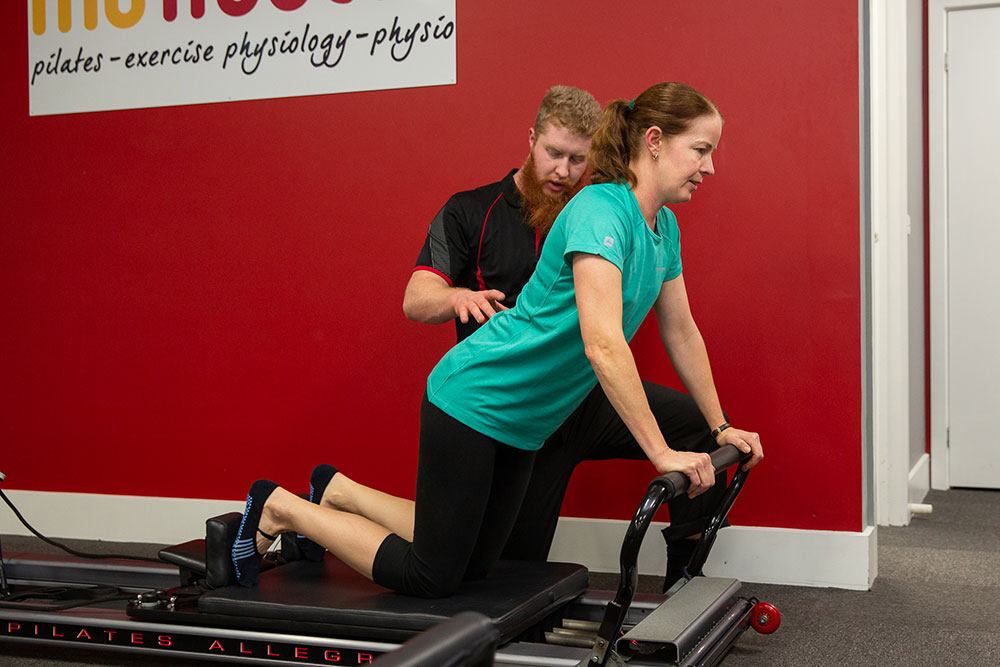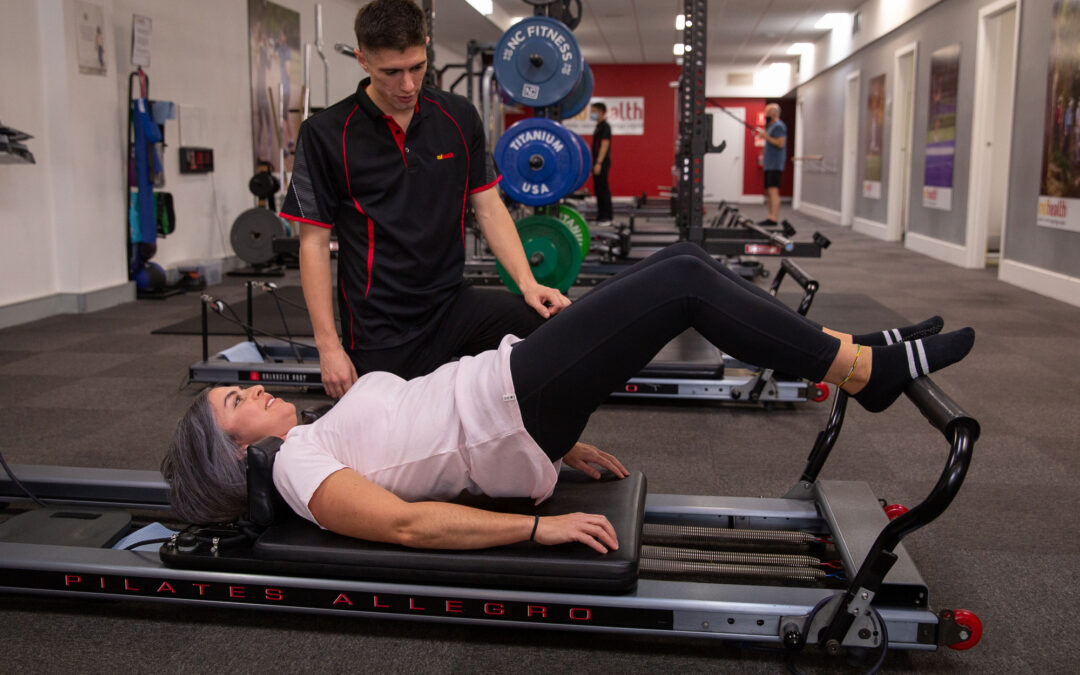Are you new to the world of Pilates and curious about how to get started? If so, you’ve come to the right place! In this blog post, we’ll explore Pilates exercises designed specifically for beginners. We’ll cover the benefits of starting a Pilates practice, essential exercises to get you going, tips for success, and much more. Let’s dive in!
Introduction to Pilates for Beginners
Pilates, a system of exercises designed to improve physical strength, flexibility, and posture and enhance mental awareness. Pilates can be a great program to improve your core stability and physical strength or can be an excellent addition to your fitness routine,
On of this biggest differences between Pilates and other forms of exercise is that a major focus of PIlates is working on the small, stabilising muscles of the body, known as “core stability” that are important for postural control and balance. Pilates is excellent for working on these types of muscles because it incorporates elements that facilitates the way your “brain” loves to learn new activities. These elements are:
- The exercises are task orientated – the exercises often involve pulling or pushing actions. Your brain can form a better picture in your mind of specific tasks, such as “pushing the carriage of the reformer with your leg” which it can form into a pattern. This is different to lifting a weight forward, which is harder for your brain to assign a task to, therefore hearder to remember and learn.
- The exercises have resistance – In Pilates, especially reformer Pilates, the exercises are against resistance (such as the springs of the reformer). This increases the load on the muscles and causes them to grow and adapt. To make a change in strength, muscles have to be loaded to have a reason to change and adapt. The spring based resistance in PIlates allows that to happen.
- Pilates exercises ask the muscles to co-contract – Because a lot of the exercises in Pilates involve a pushing or pulling action, the muscles at both the front and the back of the joints need to contract. This creates stability around the joints and a major aspect improving your balance and control
- Pilates challenges your balance in a controlled way – Finally, a large proportion of Pilates exercises requires balance. When you stand on one leg and push the reformer carriage backwards in a “scooter” exercise, this works and helps improve your balance on the standing leg. However, because the challenge to your balance can often be limited to a single direction (backwards or side ways) the “load” on your balance can be controlled to match your balance capabilities
Regardless of your exercise background, if you’re just starting your Pilates journey, the sheer variety of exercises and techniques can seem daunting, but fear not! We’re here to guide you every step of the way.
Benefits of Pilates for Beginners
Starting a Pilates practice can bring numerous benefits, including improved posture, increased flexibility, and enhanced core strength. As a beginner, you’ll quickly notice that Pilates focuses on small, precise movements that can help create better body awareness. Additionally, the emphasis on proper breathing can lead to improved mental focus and stress reduction. More specifically, Pilates has the following benefits:
- PIlates can improve your core stability – One of the biggest and wel known benefits of Pilates is core and general stability. Pilates is one the only exercise program that specifically focusss on core stability. Why is this important? The stabilising muscles around the joints (not just around the abdominal area), but around most of the joints around the body help you control the degree of “excess” movement that occurs around the joints. The allows the strong, power muscles to do their job properly within putting excess load on the loads, which can lead to injury and poor performance
- Pilates is great at building strong, lean muscle within making you too bulky – Pilates improves your muscle strength because it asks your muscles to work again loads. These loads are greater than they are required to do on a day to day basis, therefore causing a stimulus to grow and adapt. However, until classical strength training, the load are limited to is likely to make you stronger, without building up muscles that are too “bulky”
- Pilates improves your balance – Because a lot of exercises in Pilates challenge your balance in a controlled way, your balance improves. This is great for everyone, but especially for 2 surprising groups of people.
- Athletes – Because it allows better performance, especially in agaility based sports, such as soccer, basketball and other sports that require quick, change of direction
- People over 50 – The improved balance from Pilates reduces your risk of falls and allows you to maintain your balance on unstable surfaces

Essential Pilates Exercises for Beginners (Click on the name of the exercise to view the instructions)
Here’s a list of basic Pilates exercises suitable for beginners. Remember, it’s crucial to perform these exercises with correct form to maximize their benefits and prevent injuries.
Pilates Core stability exercise: This basic exercise aims to put load on the abdominal muscles in a controlled way :
Pelvic Tilt: It focuses on your lower back, promoting mobility and control.
Double leg bridging on ground: This main focus of this exercise is to work on your gluteal muscles, a major stabiliser around the pelvis
Hip hitches: This exercise works an important stabiliser on the side of the hip, the gluteus minimus muscle
McGill Curl-up: This is a very direct exercise to work on your abdominal muscles in a controlled manner
Tips for Success
As you begin your Pilates practice, here are a few tips for success:
Start Slow: Don’t rush into advanced exercises. Master the basics first.
Consistency: Practice regularly for the best results.
Listen to Your Body: If something hurts, stop and adjust. Pilates should feel challenging but never painful.
The Importance of Proper Form
In Pilates, form is everything. Correct technique ensures that you’re activating the right muscles and getting the most out of each exercise. It also reduces your risk of injury. Always remember to keep your core engaged, maintain good posture and move with control. Finally, do not worry about perfection, practice makes progress. You may find the exercises awkward at first or difficult. However, as you practice the exercises and get better, your form will improve and you will slowly be able to perform the exercises with ease.
This is also where a good Pilates instructor and/or exercise professional can monitor your form, ensure that you are doing the correct exercise in the right way and progress your exercises when appropriate.

Incorporating Pilates into a Fitness Routine
Adding Pilates to your fitness routine can provide a balance to other forms of exercise. For instance, if you usually do high-impact workouts, Pilates can serve as a low-impact alternative that focuses on strength and flexibility. If you have an existing exercise program, I would recommend doing Pilates 2 times a week to complement your existing regimen. It’s great to do multiple types of exercises to get the benefits of variety, but still ensure that you incorporate proper rest and recovery into your program to get the full benefit from your exercise choices.
The Benefits of Pilates for Overall Physical Health
In addition to core strength, flexibility, and improved posture, Pilates can offer other physical health benefits. These include better balance and coordination, increased body awareness, and even enhanced cardiovascular endurance. Regular Pilates practice can also aid in injury prevention and overall physical resilience.
Conclusion
Embarking on a Pilates journey can be incredibly rewarding. As a beginner, focusing on the basics and maintaining proper form will ensure your practice is safe and effective. Remember, it’s not about perfection but progression. Enjoy the process of learning and growing stronger with each session.
Ready to take the next step in your Pilates journey? At MD Health, we offer a range of Pilates programs tailored to all experience levels, from beginners to seasoned pros. Our certified instructors guide you through each exercise, ensuring you maintain proper form and maximize the benefits of your workout.
So, why not join us today? Take the leap and start your Pilates adventure with MD Health. Here’s to a stronger, more flexible you!
Do you have any questions?
- Call us on (03) 9857 0644 or (07) 3505 1494 (Paddington)
- Email us at admin@mdhealth.com.au
- Check out our other blog posts here
Our clinical staff would be happy to have chat if you have any questions.
Take the first step to a healthier you!
Would you prefer for someone to contact you regarding booking your Initial Physiotherapy appointment, Initial Exercise Physiology, Initial Osteopathy session or FREE Full Body Assessment*?
Or do you have any other enquiry about our services at MD Health?
Please fill in this form and someone from MD Health will be in touch with you soon.
Alternatively please call us on 03 9857 0644 (Kew East), 03 9842 6696 (Templestowe), 03 8683 9442 (Carlton North) or 07 3505 1494 (Paddington) to book now!
*Please note only the Full Body Assessment is a FREE service. The Full Body Assessment is for new clients at MD Health or returning clients who haven’t been in for 6 months or longer who intend to particpiate in our 13 Week Clinical Pilates Program**.
For all new clients who wish to come in for a one-off, casual or adhoc basis for Physiotherapy or Exercise Physiology the Initial Physiotherapy or Initial Exercise Physiology appointment is a paid service.
** The 13 Week Clinical Pilates Program at MD Health is not a lock in contract and you are not required to attend for the full 13 weeks if you do not wish.
This site is protected by reCAPTCHA and the Google Privacy Policy and Terms of Service apply.



